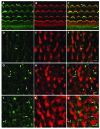Mutations of human TMHS cause recessively inherited non-syndromic hearing loss
- PMID: 16459341
- PMCID: PMC2564584
- DOI: 10.1136/jmg.2005.039834
Mutations of human TMHS cause recessively inherited non-syndromic hearing loss
Abstract
Background: Approximately half the cases of prelingual hearing loss are caused by genetic factors. Identification of genes causing deafness is a crucial first step in understanding the normal function of these genes in the auditory system. Recently, a mutant allele of Tmhs was reported to be associated with deafness and circling behaviour in the hurry-scurry mouse. Tmhs encodes a predicted tetraspan protein of unknown function, which is expressed in inner ear hair cells. The human homologue of Tmhs is located on chromosome 6p.
Objective: To determine the cause of deafness in four consanguineous families segregating recessive deafness linked to markers on chromosome 6p21.1-p22.3 defining a novel DFNB locus.
Results: A novel locus for non-syndromic deafness DFNB67 was mapped in an interval of approximately 28.51 cM on human chromosome 6p21.1-p22.3. DNA sequence analysis of TMHS revealed a homozygous frameshift mutation (246delC) and a missense mutation (Y127C) in affected individuals of two families segregating non-syndromic deafness, one of which showed significant evidence of linkage to markers in the DFNB67 interval. The localisation of mTMHS in developing mouse inner ear hair cells was refined and found to be expressed briefly from E16.5 to P3.
Conclusions: These findings establish the importance of TMHS for normal sound transduction in humans.
Conflict of interest statement
Conflicts of interest: none declared
Similar articles
-
A missense mutation in the previously undescribed gene Tmhs underlies deafness in hurry-scurry (hscy) mice.Proc Natl Acad Sci U S A. 2005 May 31;102(22):7894-9. doi: 10.1073/pnas.0500760102. Epub 2005 May 19. Proc Natl Acad Sci U S A. 2005. PMID: 15905332 Free PMC article.
-
Mutations in the lipoma HMGIC fusion partner-like 5 (LHFPL5) gene cause autosomal recessive nonsyndromic hearing loss.Hum Mutat. 2006 Jul;27(7):633-9. doi: 10.1002/humu.20368. Hum Mutat. 2006. PMID: 16752389
-
Targeted knockout and lacZ reporter expression of the mouse Tmhs deafness gene and characterization of the hscy-2J mutation.Mamm Genome. 2007 Sep;18(9):646-56. doi: 10.1007/s00335-007-9049-x. Epub 2007 Sep 18. Mamm Genome. 2007. PMID: 17876667 Free PMC article.
-
Deafness genes.J Med Dent Sci. 2000 Mar;47(1):1-11. J Med Dent Sci. 2000. PMID: 12162522 Review.
-
Autosomal recessive non-syndromic hearing loss genes in Pakistan during the previous three decades.J Cell Mol Med. 2024 Apr;28(8):e18119. doi: 10.1111/jcmm.18119. J Cell Mol Med. 2024. PMID: 38534090 Free PMC article. Review.
Cited by
-
The tetraspan LHFPL5 is critical to establish maximal force sensitivity of the mechanotransduction channel of cochlear hair cells.Cell Rep. 2023 Mar 28;42(3):112245. doi: 10.1016/j.celrep.2023.112245. Epub 2023 Mar 13. Cell Rep. 2023. PMID: 36917610 Free PMC article.
-
The genetic dissection of Myo7a gene expression in the retinas of BXD mice.Mol Vis. 2018 Feb 2;24:115-126. eCollection 2018. Mol Vis. 2018. PMID: 29430167 Free PMC article.
-
The Mechanosensory Transduction Machinery in Inner Ear Hair Cells.Annu Rev Biophys. 2021 May 6;50:31-51. doi: 10.1146/annurev-biophys-062420-081842. Epub 2020 Dec 7. Annu Rev Biophys. 2021. PMID: 33285080 Free PMC article. Review.
-
LHFPL5 is a key element in force transmission from the tip link to the hair cell mechanotransducer channel.Proc Natl Acad Sci U S A. 2024 Jan 16;121(3):e2318270121. doi: 10.1073/pnas.2318270121. Epub 2024 Jan 9. Proc Natl Acad Sci U S A. 2024. PMID: 38194445 Free PMC article.
-
The molecules that mediate sensory transduction in the mammalian inner ear.Curr Opin Neurobiol. 2015 Oct;34:165-71. doi: 10.1016/j.conb.2015.06.013. Epub 2015 Jul 25. Curr Opin Neurobiol. 2015. PMID: 26218316 Free PMC article. Review.
References
-
- Anagnostopoulos A V. A compendium of mouse knockouts with inner ear defects. Trends Genet 200218499 - PubMed
-
- Finsterer J, Fellinger J. Nuclear and mitochondrial genes mutated in nonsyndromic impaired hearing. Int J Pediatr Otorhinolaryngol 200569621–627. - PubMed
-
- Friedman T B, Griffith A J. Human nonsyndromic sensorineural deafness. Annu Rev Genomics Hum Genet 20034341–402. - PubMed
-
- Friedman T B, Liang Y, Weber J L, Hinnant J T, Barber T D, Winata S, Arhya I N, Asher J H. A gene for congenital, recessive deafness DFNB3 maps to the pericentromeric region of chromosome 17. Nat Genet 1995986–91. - PubMed
Publication types
MeSH terms
Substances
Grants and funding
LinkOut - more resources
Full Text Sources
Molecular Biology Databases




